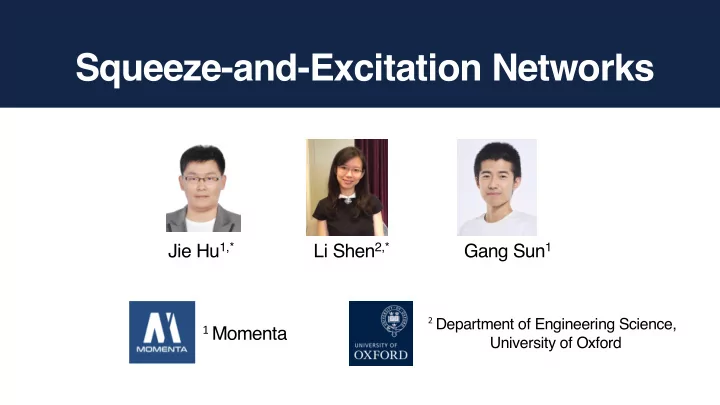

Squeeze-and-Excitation Networks Jie Hu 1,* Li Shen 2,* Gang Sun 1 2 Department of Engineering Science, 1 Momenta University of Oxford
Large Scale Visual Recognition Challenge Squeeze-and-Excitation Networks (SENets) formed the foundation of our winner entry on ILSVRC 2017 Classification SENets [Statistics provided by ILSVRC] Convolutional Neural Networks Feature Engineering
Convolution A convolutional filter is expected to be an informative combination Fusing channel-wise and spatial information • Within local receptive fields •
A Simple CNN
A Simple CNN Channel dependencies are: Implicit : Entangled with the spatial correlation • captured by the filters Local : Unable to exploit contextual information • outside this region
Exploiting Channel Relationships Can the representational power of a network be enhanced by channel relationships ? Design a new architectural unit • Explicitly model interdependencies between the channels of convolutional features • Feature recalibration q Selectively emphasise informative features and inhibit less useful ones q Use global information
Squeeze-and-Excitation Blocks Given transformation F "# :input X → feature maps U • Squeeze • Excitation
Squeeze: Global Information Embedding • Aggregate feature maps through spatial dimensions using global average pooling • Generate channel-wise statistics U can be interpreted as a collection of local descriptors whose statistics are expressive for the whole image.
Excitation: Adaptive Recalibration • Learn a nonlinear and non-mutually-exclusive relationship between channels • Employ a self-gating mechanism with sigmoid function q Input: channel-wise statistics q Bottleneck configuration with two FC layers around non-linearity q Output: channel-wise activations
Excitation: Adaptive Recalibration • Rescale the feature maps U with the channel activations q Act on the channels of U q Channel-wise multiplication SE blocks intrinsically introduce dynamics conditioned on the input.
Example Models X X X X Residual Inception Residual Inception 𝐼 × W × C 𝐼 × W × C � X Global pooling + Global pooling 1 × 1 × C 1 × 1 × C � X Inception Module FC 1 × 1 × C FC 1 × 1 × C 𝑠 ResNet Module 𝑠 1 × 1 × C ReLU 1 × 1 × C ReLU 𝑠 𝑠 FC 1 × 1 × C FC 1 × 1 × C Sigmoid 1 × 1 × C Sigmoid 1 × 1 × C Scale 𝐼 × W × C Scale 𝐼 × W × C + 𝐼 × W × C � X � X SE-Inception Module SE-ResNet Module
Object Classification Experiments on ImageNet-1k dataset • Benefits at different depths • Incorporation with modern architectures
Benefits at Different Depths SE blocks consistently improve performance across different depths at minimal additional computational complexity (no more than 0.26%). ü SE-ResNet-50 exceeds ResNet-50 by 0.86% and approaches the result of ResNet-101. ü SE-ResNet-101 outperforms ResNet-152.
Incorporation with Modern Architectures SE blocks can boost the performance of a variety of network architectures on both residual and non-residual settings.
Beyond Object Classification SE blocks can generalise well on different datasets and tasks. • Places365-Challenge Scene Classification • Object Detection on COCO
Role of Excitation The role at different depths adapts to the needs of the network • Early layers: Excite informative features in a class agnostic manner SE_2_3 SE_3_4
Role of Excitation The role at different depths adapts to the needs of the network • Later layers: Respond to different inputs in a highly class-specific manner SE_4_6 SE_5_1
Conclusion • Designed a novel architectural unit to improve the representational capacity of networks by dynamic channel-wise feature recalibration. • Provided insights into the limitations of previous CNN architectures in modelling channel dependencies. • Induced feature importance may be helpful to related fields, e.g. network compression. Code and Models: https://github.com/hujie-frank/SENet
Thank you!
Recommend
More recommend